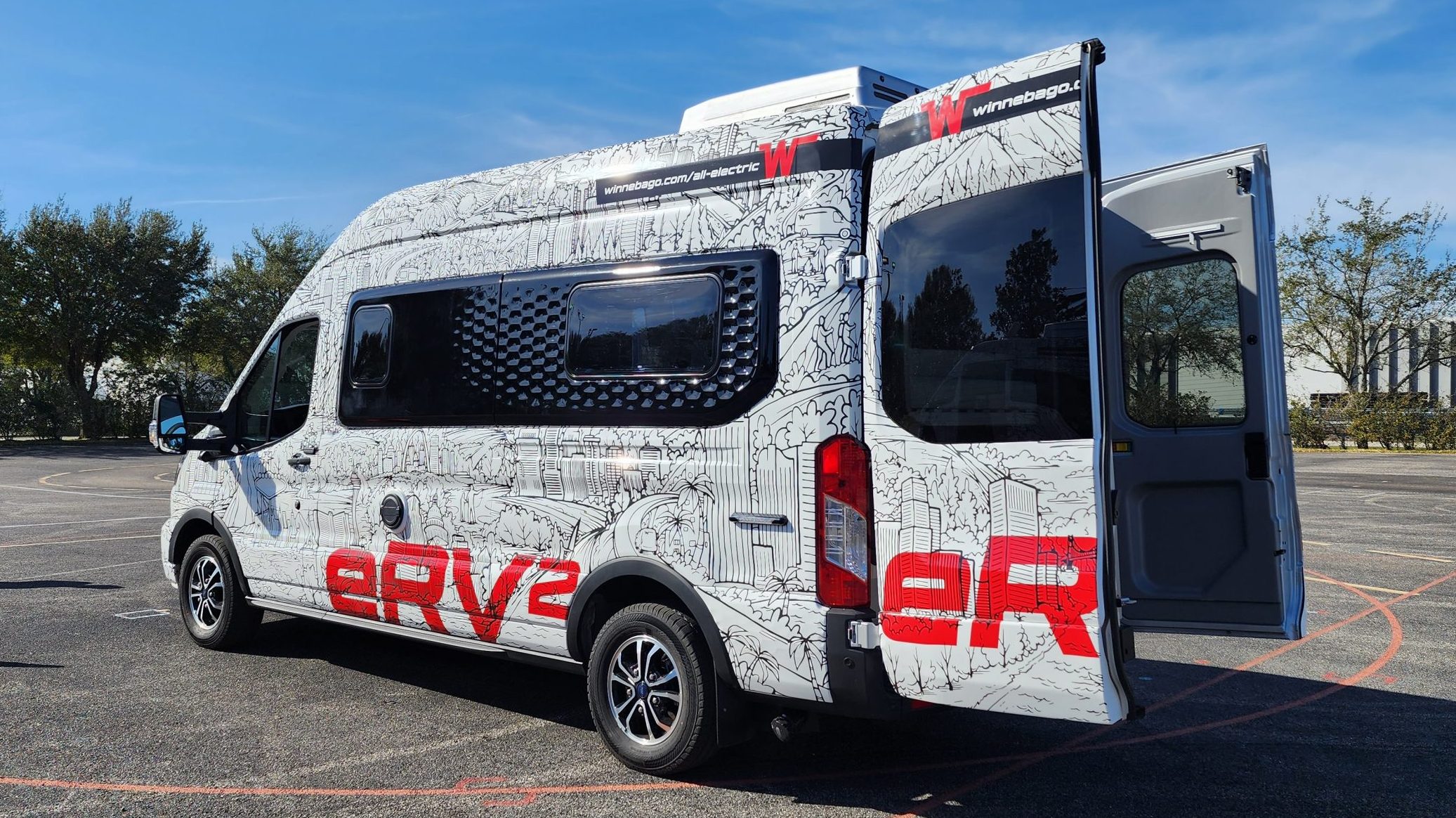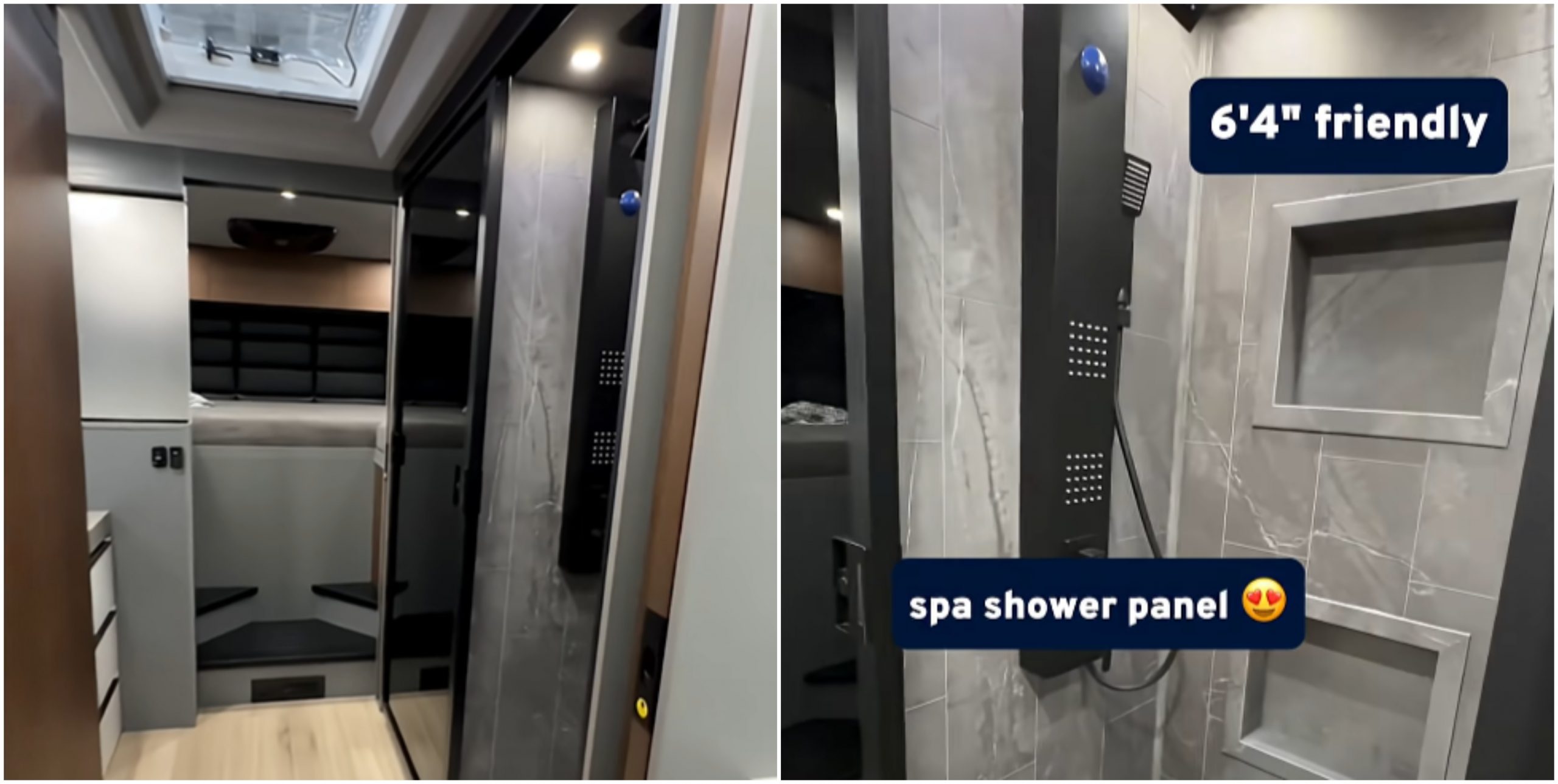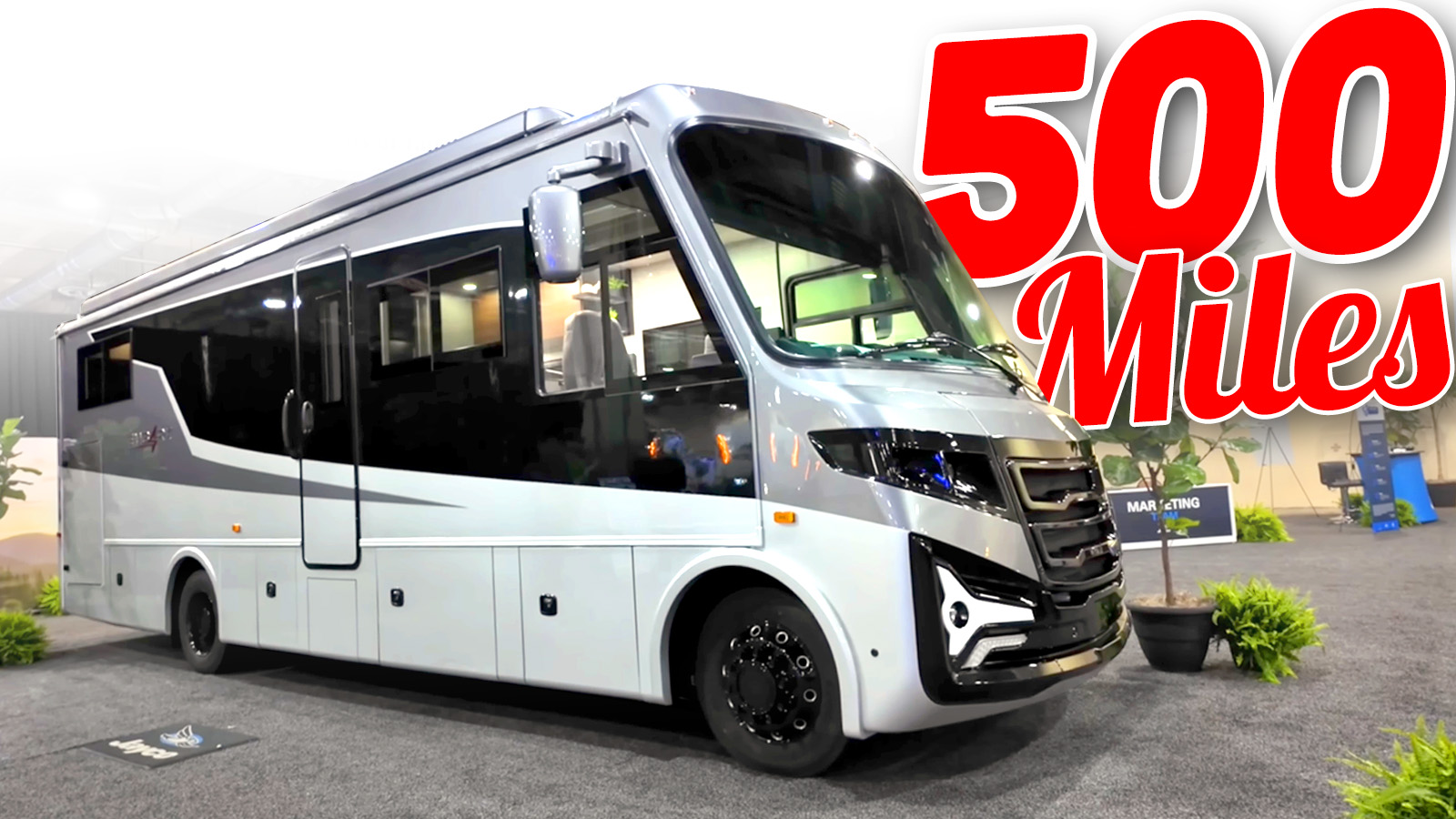Many RV manufacturers have been on a relentless mission to help clean up their industry. Some RV producers have embraced composites instead of relying on lauan wood, while others are ditching propane and other fuels for all-electric experiences. One type of RV that has missed out on the advances of electric technology is the Class A motorhome, but times are finally changing. Jayco has unveiled its new Embark EV RV, and it’s a Class A motorhome of the future with a large battery for electric-only driving, plus a range extender for longer trips. The great part? It’s actually going into production.
The RV industry has long struggled to embrace the advances of battery-electric vehicle technology. A huge part of this is due to the fact that most RV manufacturers do not build powertrains, and many do not even create their own chassis. Instead, the RV companies have to work with what’s on the market.
In the past, when RV manufacturers flirted with the idea of making an all-electric coach, they started small with all-electric camper vans. You may remember the Winnebago eRV2 that I drove back in early 2023. That camper, which was based on a Ford E-Transit, went only 104 miles on a charge, which is just unacceptable for a camper van. Nowadays, the highest-range electric camper vans are based on GM’s BrightDrop vans, which can go over 270 miles on a charge.

There are now other choices in the market, too, from travel trailers that don’t carry propane to innovative self-propelled campers like the Lightship and the Pebble, both of which are now in series production. But you’ll note that none of these are Class A motorcoaches, the largest motorhomes that people buy in America, Europe, and elsewhere.
On the smaller side and lower end, Class A motorhomes tend to be powered by lumpy gasoline engines like Ford’s 7.3-liter Godzilla V8. Before that, gassers had chunky Ford 6.8-liter Triton V10s. As you can imagine, the drivers of a gasoline-powered coach would be lucky to see above 7 mpg. Rear-engine diesels, which are often powered by powerplants like the B6.7 or the Cummins X15, push even larger luxury coaches — typically up to 45 feet long here in America — might get 8 mpg or a touch more. Either way, if you own a big coach and drive it a lot, you’ll be burning tons of fuel, literally.

Going Electric
Unfortunately, as I stated earlier, RV manufacturers do not typically develop powertrains and often don’t make their own chassis either. Thor Industries, one of the top RV conglomerates in America, figured out a solution. It might not have built an EV platform, but what if it started a strategic partnership with a company that did? In late 2022, Thor Industries and Harbinger Motors announced a partnership to create advanced electric motorhomes.
I got to check out Harbinger’s platform at the 2023 RV Open House in Indiana, where I was impressed with the engineering at Harbinger. At the time, Harbinger and Thor were working on a platform that would have produced 250 miles of all-electric range, which remains unheard of in the Class A space. Granted, that’s also not a ton of range for a motorhome. Diesel coaches often have 150-gallon fuel tanks, ensuring a driving range of 1,000 miles even at 7 mpg.

As it turns out, Harbinger and Thor already had the solution in the works. Instead of going all-in on a pure battery-electric motorhome, the pair have created the world’s first hybrid-electric Class A motorcoach. The Thor Test Vehicle, which our Jason Torchinsky got to drive, works like our favorite extended-range EVs, like the iconic BMW i3 and the Chevy Volt. The coach has a big battery pack, which feeds an electric powertrain. There is an internal combustion engine onboard, and its entire job is to generate electricity.
As a motorhome, the platform that Harbinger made with Thor is capable of going over 100 miles on electric power alone, then the engine kicks in, extending range to 500 miles.

Not only is this much better than a pure electric motorhome, but crucially, the platform works like any other EREV, where you can just refill the fuel tank and then hit the road again in only minutes. It’s the best of both worlds, given the technology that we have right now.
Now, it’s time to see what a production version of Harbinger’s platform looks like. Sadly, Jayco has not published any press release or anything like that, and only dealerships, influencers, and industry media have gotten to see it. The images that you see here are from a video from influencer ‘THATRVGIRL‘ and as well as Camping World on YouTube.
The Jayco Embark EV
Back in mid-August, Jayco kicked off its Dealer Homecoming event. During the event, Jayco pulled the covers off its latest motorhome, the Embark EV. RVBusiness covered this, and here’s what Jayco told the industry publication:
“When THOR had asked us to partner with Harbinger to develop this, for us, it was an incredible opportunity to really lead the charge into what will probably be the next generation of RVing,” Jayco Director of Product Development Cory Weatherford told RVBusiness. “The chassis itself with this size of a motorhome on it is 22,000 pounds and, off of all electric, we can go approximately 110 miles. Harbinger did develop a gasoline range extender on this. So, the engine is powering a 45-kilowatt hour generator which is powering the batteries. Depending on driving conditions, you’re at approximately 475 to 500 miles.”

RVBusiness did not get deeper into the details of the electric drive system. Back when Jason wrote about the Thor Test Vehicle, he noted that the Harbinger chassis featured four batteries adding up to 140 kWh and an inline four combustion engine to work as the generator. What we do know is that this engine is fed from a 50-gallon fuel tank.
RVBusiness also notes that, perhaps unexpectedly, the coach doesn’t have solar panels. This is reportedly because, in Jayco’s eyes, the up to 1,500-watt panels available to companies like Jayco right now are totally inadequate for even trickle-charging the traction battery. Instead, Jayco expects owners to run the combustion engine or to hook up to shore power or an EV charger to recharge the battery.

This seems like a huge missed opportunity, because sure, while solar isn’t going to recharge the battery, it can be used to power lighting, smaller appliances, and other features. That’s what other electric RV designs are using solar for right now.
The Embark name was used before on a Jayco line of Class A coaches that started at 37 feet long. Those older ones featured Spartan K1 rear-engine chassis with Cummins B6.7 diesels with 360 HP and 800 lb-ft of torque. This new Embark EV measures 30’9″ long and 11′ tall, making it on the small end of Class A designs.


RVBusiness says that the Embark EV has a Euro-style design, which has been a trend in the American RV industry lately. From RVBusiness:
The main living contains a collapsible stowaway dinette table that makes room to open up the floor from the front to the back of the coach. Two large skylights provide natural lighting, but shades provide for privacy and keeping things dark at night.
The bathroom is separated into two compartments – one for the shower and one for the toilet – that can be closed off with sliding doors. In the living area, a 39″ TV is on a lift and a JBL Aura Cube House Radio provides the sound system.
Kitchen features include a convection microwave, a 12-volt InVision 8-cubic-foot refrigerator and combination induction/LP cooktop. Hot water is provided by a Suburban tankless water heater and the coach can be heated with a Dometic furnace. Sound-deadening acoustic panels help keep out any road noise during travel, which is minimal anyway since there is no engine driving the vehicle.
It Costs How Much?
Jayco says that the Embark EV will go into limited production over the next year for the price of $460,000. Yes, that price commands a huge premium over other coaches of this size, class, and level of luxury. For example, the Jayco Alante 29F, which rides on the Ford F-53 chassis with a Godzilla gasoline V8, is two feet longer than the Embark, but costs $193,058. Even the 38’10” Jayco Precept is $232,650.
Jayco does not currently market any diesels, but Thor Industries is a huge umbrella. The smallest diesel sold by Thor Motor Coach is the 34’11” Palazzo GT, which starts at $300,020. So, no matter how you slice it, you’re paying a lot of extra money for the hybrid system and the Euro-inspired design. However, I could see the Embark EV decreasing the cost gap over time with its cheaper running costs.

I am genuinely excited to see innovation coming from the big RV companies. We’re huge fans of EREVs at The Autopian, and it’s so cool to see the technology implemented into different modes of transport like aircraft and RVs. An extended-range electric RV has a big battery for off-grid camping, can be quieter when going down the road than its pure gas or diesel counterparts, and shouldn’t hurt as much when you arrive at a gas pump.
Once RV companies nail down the pricing, I think these could become a pretty big deal. Either way, I can’t wait to see more of what Harbinger has been cooking up for the RV industry.
Topshot: Screenshot: THATRVGIRL/Youtube








“ the engine is powering a 45-kilowatt hour generator”
As an engineer this is like fingernails on a chalkboard. It’s a 45-kilowatt generator. I see this unit mistake all the time from manufacturers and journalists alike.
How does that frame match up with a typical ClassA? I know on most ClassA rigs there are vast passthru storage bays underneath but am curious if the frame had to be larger to accommodate?
Jayco is part of Thor, which is the company strip mining the rainforest to make incredibly shitty RVs and travel trailers. I doubt they have any real interest in making a hybrid RV.
The company I work for is providing a new building for Jayco. I wonder if this is what will be built there.
I’m not sure 60hp is going to be enough to actually delivery any extended range for an RV though…. Not to hate on the idea. It is a great idea. But you probably need more like 75-100 KW to make it viable on an RV. Remember the I3 failed to keep up at speed with a 25 KW motor, and this has to be at least 4x higher drag (rolling+aero) over that.
I’m not saying that this thing needs to be able to go 90 mph and recharge, but if it can’t recharge battery under its own steam above 70 mph it will be DOA, and… suspiciously… I’m doubtful.
a camper that costs $500,000 is always just a joke to me.
I can promise you 2500 hotel stays ( thats nearly 7 consecutive years in 200 dollar a night hotels) near a national park where you have a small car with you will be more trouble free, easier on your back, and have much nicer bedrooms.
Do you think this thing will even be able to drive in 7 years?
But you have to forgo the joy of emptying a chemical toilet!
A plus for hotels with actual flushing toilets, and maid service.
Yup. RVs, in general, are just a terrible value all the way around, which is why the vast majority of them are built so incredibly poorly. They need to be made as cheaply as possible. The few that aren’t 100% garbage are outrageously expensive and appeal to a very small audience that can spend $300k plus for a chuckle.
My take exactly, without needlessly wasting resources and burning more fuel and creating more pollution, and without pissing off everyone on the road with a house on four wheels.
This seems a bit like a diesel locomotive for the road. This is a good Idea and prices will drop or level off. Many RVs are plugged in at campgrounds and I wonder if that will help keep the battery up. I am sure there are people who will hate it for some reason. It is at least a start.
How are campgrounds going to react to these EREV RVs coming in and gobbling up a bunch of electricity to re-charge their batteries?
Do they have the electrical capacity to support this load?
Will they have to individually meter each hookup and add an surcharge based on usage to the campsite bill?
Most large rigs require a 50A hookup as-is. The difference here is while you’ll have a large initial load, with that much battery on board, there will be much more stable flow once the batteries are topped up.
Crucially, these would be amazing for places like racetracks, where you won’t have dozens of gensets running non-stop.
Same explanation for EVs in general. We already have enough grid robustness, as not everyone will be both charging or pulling any full load all at the same time.
The short answer is “no”.
A lot of campgrounds can barely handle hot days where everyone is running their AC, and chances are that’s not close to maxing out their 50A connection. If you have a bunch of these pulling the full 50A at 240V that they theoretically can, a lot of campground electrical systems are going to fall over. Which is to say nothing of the cost of someone pulling 140 kW. You’re talking about an amount of electricity that costs ~50% of the nightly fee to stay in a lot of campgrounds. Sure, it’s only for that first day since after that the batteries will be charged, but a lot of people overnight on their way to destinations and that will destroy the economics of campgrounds.
These are probably solvable problems, but if someone isn’t thinking about how then they’re making the same mistake EV car manufacturers did – investing in the cars without also investing in the infrastructure to support them.
“a relentless mission to help clean up their industry”? How about they build stuff that doesn’t fall apart within the first year of use?
“As you can imagine, the drivers of a gasoline-powered coach would be lucky to see above 7 mpg. Rear-engine diesels, which are often powered by powerplants like the B6.7 or the Cummins X15, push even larger luxury coaches — typically up to 45 feet long here in America — might get 8 mpg or a touch more. Either way, if you own a big coach and drive iGt a lot, you’ll be burning tons of fuel, literally”
And you still are. 400 miles on 50 gallons works out at best to that very same 8 MPG. 🙁
So what’s the point again?
Well 140 kWh works out to 4.2 GGE which if it gets you 110 miles translates to 26.2 mpge. By my maths that makes the REX in this thing about 30% thermally efficient compared to the electric system which I think is disappointing. Pop in a 40% TE Toyota ICE and that 8 mpg should go up to 10.7 mpg. Take it to the next level with a 50% TE Nissan Epower REX and you might see 13.3 mpg on gasoline.
If anyone wants to fact check this I’d welcome it.
Tests of the Nissan Epower give between 6 and 7 L/100km. So I call bullocks on the 50% TE. Must be some weird way to describe efficiency. Gasoline to stored electricity would be good if half that.
https://www.vroom.be/nl/informatie/nissan-qashqai-e-power-2024-prijs-verbruik
Unfortunately that link came up in Dutch and the only other language option appeared to be French so to my ‘Murican eyes its a bunch of scribbles.
I did however find an English language Australian test that managed 5.4L/100 km:
https://henryman.net/2024/11/10/nissan-e-power-review/
Sounds better but they me tion they managed 5.0L/I00 km in a Kona hybrid. So your point stands.
I dunno what’s going on with Nissan’s claims but I really hope they get their act together before they drop this thing in the US next year.
Still Nissan wasn’t the only claim of 50% TE:
https://carbuzz.com/news/mercedes-amg-just-cracked-50-thermal-efficiency-with-new-f1-engine/
So my hope for 50%+ isnt quite dead yet.
GMC needs to make a motohome again.
I prefer the idea of retromodding the originals.
Oh MAN, this drivetrain solution would be a great candidate for returning to the FWD GMC motorhome.
May get those MPG numbers up, too.
You could probably do it with a Volt as a donor.
The Volt definitely has the torque, but I’d suggest beefing up the CV boots from their stock form. (I’m not actually sure if the ELR got sturdier ones for its crazy 230ish-HP tune.)
Also: mountain mode will probably be your default. I wouldn’t want to try climbing a long hill relying solely on the 84hp generator.
“Also: mountain mode will probably be your default. I wouldn’t want to try climbing a long hill relying solely on the 84hp generator.”
What’s mountain mode?
In a Volt, it reserves 10 miles of battery. Once you hit that number it automatically switches to generation mode.
Yes thank you!
I think it reserves more than 10 miles though. Doesn’t it reserve half the battery capacity (which in mine is 10.5/2 = 5.25kWh)?
And @CheapGentlemanBornOutOfWedlock It’s there to provide a reserve of power on long uphill grades, as well as enough room to absorb a few kWh on the way back down.
Not sure if it’s different between generations, but my Gen 2 only holds 10 miles (at least what the screen says).
It very well might; the Gen 1 was famously built and programmed very, very conservatively, so I can definitely see the Gen 2 being better optimized!
Ah. I was kinda hoping it was there to switch the ICE into Otto mode for more power.
I think that’s only a low-speed option to add traction to very specific Beetles and Changlis.
A derivative of Trunk Monkey to be sure.
Well in a motor home there’s plenty of room for MOAR BATTERY! Which is good because you’ll need it.
Yeah, no. Maybe if it was made by Leisure Travel Vans or a similarly high-quality OEM, then sure. But a Thor Industries product? lol
Yeah this is a dead end. The EV only range is too limited for this price point and once it reaches min SOC it will struggle to match the MPG of an ICE powered version or struggle with anything resembling a grade, or maybe both.
Charging at a DCFC will be next to impossible for the foreseeable future as sites simply aren’t designed for anything approaching that size. You might be able to get a meaningful charge at a camp ground though.
Still no way this thing could ever result in savings with that initial purchase price.
The original Tesla Roadster cost a base price of nearly $150k (adjusted for inflation). They gotta start somewhere, the price will come down.
My initial reaction is that it’s an interesting concept. My first question is how to get Onan (or a similar established RV supplier) involved, combining both the REX function and the boondocking power function into one proven, durable unit. My other thought is that solar panels shouldn’t be dismissed. They can do a great job providing a trickle charge during the inevitable periods the unit ends up in storage.
Boondocking can be done with this setup. You’re using an inverter to pull battery voltage and supply 120VAC. What charges the pack is irrelevant.
Well did you know you can rent JK Rowling’s yacht, and it has a 4500 mile range? I can’t find just how many gallons it takes or it includes the helicopter or the service boat. It has 12 suites but no library. But that $450,000 is chicken feed to the $1.5: million a week rental cost
It’s nice that The Autopian is covering RV innovations, but I don’t really understand the use case for this particular RV besides “because we can.” For most EVs (personal and commercial), it seems that the primary use is short trips within battery range, and occasional longer journeys that require charging on-the-road or a range extender.
A motor home with a 110 mile electric range seems hamstrung from the start, since presumably most trips in a vehicle like this are longer trips. So every vacation is essentially running on a 4-cylinder generator for the majority of the journey (110 mile EV range, 390 mile additional ICE range). And that ICE seems to be delivering barely 8 MPG (50 gallon tank for 390 incremental miles).
[channeling my inner Toecutter here] I’m surprised a vehicle of this type isn’t more aerodynamic and lighter. Maybe start with a body style akin to a Vixen motor home?
Can you see a fuel tank larger than the water tank to make it useful?
I feel like there are basically two categories of part-time RVers in the US. One of them goes to the same half dozen campgrounds near-ish to their home most weekends all season and the other puts the hammer down at 5 PM on a Friday to get to their destination half way across the country at 3 AM. The former could easily work with this, the latter could not care less.
Historically my family has been more the latter, living in Ohio. There’s not much within a couple hours’ drive so we just want to get a box full of our stuff as far from home as we can over a long weekend.
Fulltimers are an entirely different breed. I feel like if I was able to fulltime I could go to a full EV RV without much worry. If I have maybe 150 miles of real world range and no time constraints I could happily explore the country with little worry, but as long as you have to get back home by a certain time it’s really hard to avoid burning dino juice.
That’s a good point. The full time RVers tend to take their time and only want to drive a few hours a day they will also just relax in the right lane with the trucks. It’s almost like the difference between sailboats and motor boats. Even under the engine power the sailboat is maybe going 10knots where the power boat could be double or tripple that.
Burning through a 50 gallon tank is more palatable from a financial and environmental standpoint than 150 gallons. I suspect this is only the beginning and things can get a lot better.
“Burning through a 50 gallon tank is more palatable from a financial and environmental standpoint than 150 gallons”
Only for people tragically inept at 4th grade math.
Harbinger is almost like an indie darling. They always pop up with talk like they are the best thing ever but very limited production. But RVs could be their natural place. It’s already confusing with multiple vendors and upfitters. The fleet stripped chassis and step van buyers want simple warranty work and someone they can blame and hold accountable if it goes wrong.
Yes because the regular RVs are built with such a great build quality and never have issues. Frankly it isn’t a bad idea to compete in the lowest quality highest price market
Especially with Thor is a match made. Sorry for the poor guy that buys one though. But maybe by the time it bricks it’s self it will be a leaky mold brick anyway.
So… Harbinger is in a weird spot.
They have good tech for their module/pack architecture, de dion rear suspension for MD EV’s, all electric power steering (unique for this weight class), among other things.
But their problems are:
Conservative fleet manages for Step-vans really just want to keep buying from FCCC or Ford.Step Van market isn’t that big, so they need to pivot to RVs. But most RV owners aren’t going to line up for this thing and whatever price they are trying to sell it as. Also… are we SURE that 4 cylinder chinese engine meets EPA/CARB emissions guidance? Will it really have enough juice to push this up the Davis Dam at the speed limit at full GVWR with the batteries depleted?Their cutaway cab design isn’t good enough (from some 3rd party), and isn’t designed well for mass production. And to design/tool/build a brand new all-steel cab (like a class 4-6 truck) would cost >$40m… money I don’t think they have.Incentives are drying up (at least for the next couple of years) for commercial EVs.Cost. I don’t know the exact cost of their platform, but I’m sure it’s not as cheap as it needs to be to scale.(Trying to be) an acquisition target is very bad right now… a few years ago another org (i.e. Cummins/Accelera) might have wanted to purchase Harbinger… now I’m not so sure about that.Lastly… they seem to have “founder’s syndrome”…. I’ll leave it at that.
JFC why does it autoformat like this ^ from numbered lists. I may sound crazy most of the time, but usually not this stupid.
Funny you mention Harbinger they have (or had have not seen it out testing in a bit) a test mule where I work and that thing is a big oof always falling apart and crap breaking on it and the drivers hate the thing haha.
Neat. If it’s at least solar ready, that’s a step in the right direction. Free amp-hours are free amp-hours.
Correct.
Depends on whether you can park it in the sun and whether you have to keep moving it to keep the panels in the sun.
True. Still, anything helps. Also helps on drives for recharging the house battery. I’m adding solar onto my camper for that exact reason.
I imagine it helps charge the house battery even more just parked on the driveway.
Since LFP batteries don’t much care about state of charge, having it ready to go is easy. Especially when nothing active has to be done.